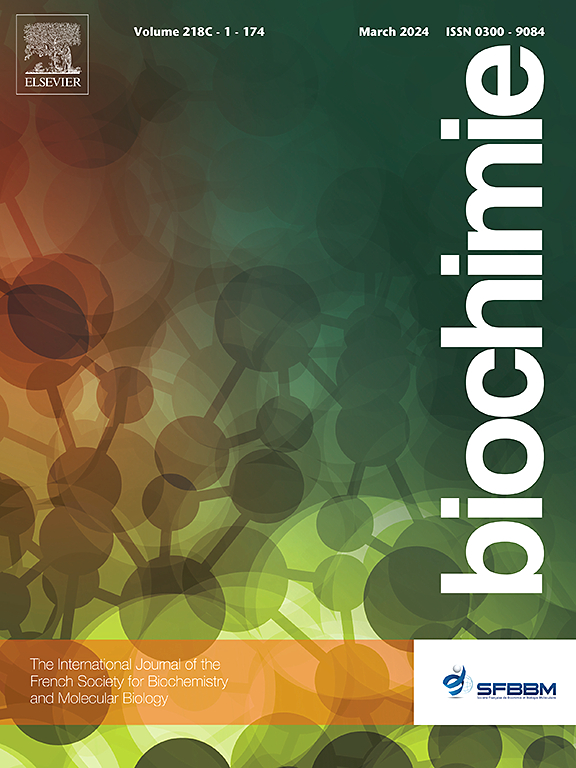Nitazoxanide通过靶向BamB与多粘菌素B协同靶向耐药大肠杆菌抑制菌毛组装。
IF 3.3
3区 生物学
Q2 BIOCHEMISTRY & MOLECULAR BIOLOGY
引用次数: 0
摘要
革兰氏阴性菌的致病性依赖于菌毛的聚集,而菌毛的生物发生由伴侣-引导(CU)途径调控。Nitazoxanide (NTZ)通过特异性干扰外膜蛋白(OMP) usher的适当折叠(主要由β-桶组装机械(BAM)复合物介导),抑制CU途径介导的P菌生在这项研究中,我们确定了BAM复合物组分BamB和BamA POTRA2结构域是NTZ的关键结合靶点。分子动力学模拟和生物层干涉分析表明,BamB残基S61和R195是NTZ结合的关键。NTZ激活了Cpx双组分系统,引起了由错误折叠的P毛亚基积累引起的内膜扰动。还观察到ibpAB基因的上调,该基因保护细菌免受ntz诱导的氧化应激。重要的是,NTZ与多粘菌素B联合使用可增强多粘菌素B对易感和mcr阳性大肠杆菌的抑菌活性。这种增强是通过ntz诱导的内膜通透性、氧化应激、外排泵活性和生物膜形成的抑制来实现的。本研究为NTZ的抗菌机制提供了新的见解,并强调了其作为抗生素佐剂的潜力,通过靶向BamB抑制CU途径,恢复多粘菌素B对多重耐药细菌的疗效。本文章由计算机程序翻译,如有差异,请以英文原文为准。
Nitazoxanide inhibits pili assembly by targeting BamB to synergize with polymyxin B against drug-resistant Escherichia coli
Gram-negative bacteria rely on pili assembly for pathogenicity, with the chaperone-usher (CU) pathway regulating pilus biogenesis. Nitazoxanide (NTZ) inhibits CU pathway-mediated P pilus biogenesis by specifically interfering with the proper folding of the outer membrane protein (OMP) usher, primarily mediated by the β-barrel assembly machinery (BAM) complex. In this study, we identified the BAM complex components BamB and the BamA POTRA2 domain as key binding targets for NTZ. Molecular dynamics simulations and Bio-Layer Interferometry revealed that BamB residues S61 and R195 are critical for NTZ binding. NTZ activated the Cpx two-component system and induced inner membrane perturbations, which resulted from the accumulation of misfolded P pilus subunits. Upregulation of the ibpAB gene, which protects the bacteria against NTZ-induced oxidative stress, was also observed. Importantly, NTZ combined with polymyxin B enhanced the latter's antibacterial activity against both susceptible and MCR-positive E. coli strains. This enhancement was achieved through NTZ-induced increases in inner membrane permeability, oxidative stress, and inhibition of efflux pump activity and biofilm formation. This study provides new insights into the antimicrobial mechanism of NTZ and highlights its potential as an antibiotic adjuvant by targeting BamB to inhibit the CU pathway, restoring the efficacy of polymyxin B against multidrug-resistant bacteria.
求助全文
通过发布文献求助,成功后即可免费获取论文全文。
去求助
来源期刊

Biochimie
生物-生化与分子生物学
CiteScore
7.20
自引率
2.60%
发文量
219
审稿时长
40 days
期刊介绍:
Biochimie publishes original research articles, short communications, review articles, graphical reviews, mini-reviews, and hypotheses in the broad areas of biology, including biochemistry, enzymology, molecular and cell biology, metabolic regulation, genetics, immunology, microbiology, structural biology, genomics, proteomics, and molecular mechanisms of disease. Biochimie publishes exclusively in English.
Articles are subject to peer review, and must satisfy the requirements of originality, high scientific integrity and general interest to a broad range of readers. Submissions that are judged to be of sound scientific and technical quality but do not fully satisfy the requirements for publication in Biochimie may benefit from a transfer service to a more suitable journal within the same subject area.
 求助内容:
求助内容: 应助结果提醒方式:
应助结果提醒方式:


